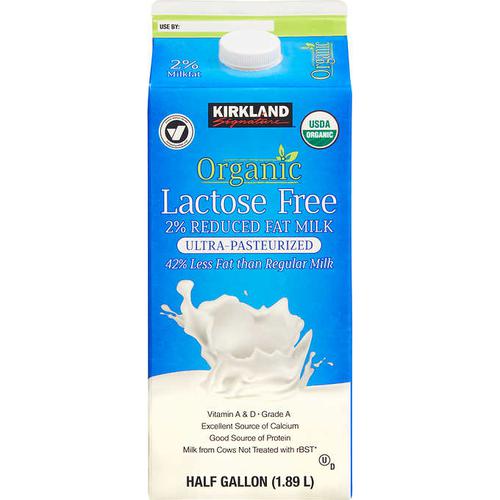Diet and Nutrition for Lactose Intolerance
Lactose intolerance is one of the most common digestive problems in the world. It's the inability to digest a sugar molecule called lactose. The sources are dairy products like milk, cheese, and yogurt.
The deficiency or absence of lactase, an enzyme usually produced in the small intestine responsible for the breakdown of lactose, causes the problems. In these individuals, lactose travels through the gut undigested, leading to some very unpleasant symptoms. The most common symptoms include nausea, abdominal pain, gas, bloating, and diarrhea.
The best way to manage this condition is to adjust your diet and keep in mind certain lactose intolerance foods to avoid.
How to Adopt a Lactose Intolerance Diet
Make sure that you consult with your dietitian before making any drastic dietary changes. They'll be able to adopt a lactose intolerance diet to your nutritional needs.
1. Lactose-free diet
In order to prevent the bloating and flatulence caused by dairy, you can substitute these products for ones that contain reduced levels of lactose or none at all.
-
Butter: Although it's a dairy product, butter is made by separating its liquid and solid components. The removed liquid contains all of the sugar, resulting in very low lactose levels.
-
Hard cheese: Cheese is produced by adding bacteria to milk, turning it into curds and whey. The majority of the lactose-containing whey is removed in the process of cheese production. Additionally, the longer a cheese is aged, the less amount of lactose it contains. Bacteria within the cheese continue to break down the sugars as it ages. Thus, hard aged cheeses, like Parmesan and Swiss, are usually a safe addition to any lactose intolerance diet.
-
Yogurt: Most yogurt products are easier to digest than milk. Yogurt contains bacteria aiding the individual's gut in lactose digestion. The best kind of yogurts to include in your diet for lactose intolerance are ones labeled as probiotic or full-fat. Avoid pasteurized yogurts as the pasteurization process kills the bacteria.
-
Heavy cream: Remember this: higher fat content leads to low lactose levels. Heavy cream contains very high levels of fat while being very low on lactose. Try replacing the milk in your coffee for heavy cream in order to reduce your symptoms!

2. Foods with rich calcium
Since milk and cheese are the most common sources of calcium, it's essential that your lactose intolerance diet includes other calcium-packed foods:
- Soft-boned fish, such as salmon or sardines
- Broccoli
- Spinach
- Almonds
- Dried beans
- Tofu
- Products fortified with calcium, such as cereal and juice
3. Foods rich in vitamin D
Milk is a common source of vitamin D, which helps you absorb and use calcium. It's crucial that you consume enough of this vitamin as most adults already suffer from vitamin D deficiency:
- Eggs
- Salmon
- Oranges or orange juice
- Liver
Managing Your Lactose Intolerance
Insufficient dairy consumption, due to unmet calcium and vitamin D requirements, can lead to illnesses. In children, a milk-free diet can lead to reduced bone mass. In older adults, especially postmenopausal women, a dairy-free diet increases the risk for osteoporosis.
Every individual with lactose intolerance has their own degree of lactase deficiency. Therefore, they can all handle different amounts of lactose before showing symptoms. The key is determining the amount of lactose you can include in your lactose intolerance diet in order to avoid digestive issues while also fulfilling your nutritional needs.
- Ingesting small amounts of lactose
Instead of eliminating lactose products from your diet completely, try consuming it in very small amounts. Make sure you space out these products throughout the day; that allows your gut to process them with ease. Most people with lactose intolerance can consume up to 12 grams of lactose in a single sitting without experiencing any symptoms.
- Combining dairy products with other foods
By mixing the lactose-containing products with other foods to make a more complex meal slows down lactose digestion. This means that your gut will require smaller amounts of lactase at any given time. By incorporating higher amounts of fiber into your diet, the process of digestion is slowed even further.
- Consuming lactase products
There's also the option of taking a supplement that contains extra amounts of lactase enzyme. These products are usually found in tablets or a solution and are taken immediately before ingesting lactose-containing foods. This is a great option as it allows you to continue consuming milk, cheese, and other dairy products. Remember to consult with your doctor before using this product.
Conclusion
Lactose intolerance doesn't have to ruin your life. You can continue consuming dairy products as long as you opt for butter, hard cheeses, or yogurt. All of these contain lower amounts of lactose. Also, you can space out your intake of lactose or take lactase enzyme tablets before your meals. Just remember to meet your daily calcium and vitamin D requirements!
YOU MAY LIKE
-
Shed Those Extra Pounds With Lean Meat
-
Vegetables in a Bottle - Analyzing the V8 Juice
-
Low Carb Diet: Is It More Than Just a Fad?
-
Best Ways to Increase Blood Count
-
Is It Bad to Drink Cold Water? - Find Out the Answer Now
-
Best Tips to Stop Binge Eating at Night
-
Best Foods to Eat Before Workout
-
5 Shocking Apple Cider Vinegar Side Effects to Watch Out
-
Almond Butter vs. Peanut Butter – Which One Is Better?
-
Best Ways to Drink Water Daily
